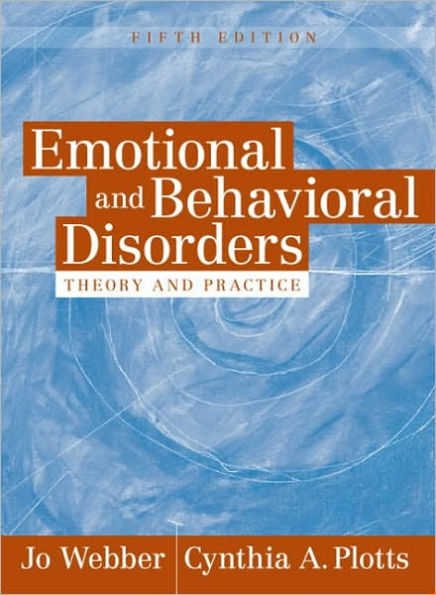Table of Contents
Preface xv
Contributors xvii
Chapter 1
Definition and characteristics
Questions to Consider
Orientation
Overview
Defining Emotional/Behavioral Disorders
Factors Influencing Concepts of Deviance
Sociological Parameters of Behavior
Concomitant Disorders
Defining and Classifying Emotional/Behavioral Disorders
A Conceptual Framework of EBD Characteristics
Dimensions of Emotional/Behavioral Disorders
Demographics
Social ad Behavioral Characteristics
Intellectual and Academic Functioning
Language Characteristics
School Outcomes
Teacher Characteristics
Prevalence
Conclusions
Key Points
Homework Questions
Additional Readings and Resources
Chapter 2
A Historical Perspective
Questions to Consider
Orientation
Overview
Ancient Views: Greeks and Romans
Early Middle Ages to the 1600s (Segregation Phase)
1700s to 1800s (Transition Phase)
Early 1900s (Service Phase)
Mid-1900s
Research and Emergence of Model Programs
National Trends
1960 to 1980
Model Programs and Research
Legislation and Litigation
1980s to 1990’s
Political Climate and Legislation
2000 to Present
Political Trends and Legislation
Status of Services for Students with EBD
Model Programs
Interagency Collaboration
Conclusions
Key Points
Homework Questions
Additional Readings and Resources
Chapter 3
Identification and Assessment
Questions to Consider
Orientation
Overview
Federal Law Definition
Procedural Requirements Under IDEA
Comorbidity of Other Disorders with Emotional/Behavioral Disorders
National Association of School Psychologists Guidelines
Assessment Procedures
Prereferral Interventions
Tests and Techniques for Assessment of Emotional/Behavioral Disorders
Systematic Screening for Emotional/Behavioral Disorders
Role of the Special Education Teacher in Identification
Linking Assessment to Intervention
Multicultural Considerations
Conclusions
Key Points
Homework Questions
Additional Readings and Resources
Chapter 4
Biophysical Model
Questions to Consider
Orientation
Overview
Definition and Basic View
Etiology and Development of Disordered Behavior
Typical Evaluation Procedures
Educational Applications
Summary
Conclusions
Key Points
Homework
Additional Readings and Resources
Chapter 5
Psychodynamic Model
Questions to Consider
Orientation
Overview
Definition and Basic View
Etiology and Development of Disordered Behavior
The Psychodynamic Goal: Healthy Development
Typical Evaluation Procedures
Educational Applications
Summary
Conclusions
Key Points
Homework Questions
Additional Readings and Resources
Chapter 6
Cognitive Model
Questions to Consider
Orientation
Overview
Definition and Basic View
Etiology and Development of Disordered Behavior
Short-term Cognitive Processes
Long-term Cognitive Processes
Cognitive Interventions
Cognitive Evaluation Procedures
Questionnaires
Educational Applications
Rational Emotive Behavior Therapy
Interpersonal Problem Solving
Self-management or Self-regulation
Additional Cognitive Strategies
Summary
Conclusions
Key Points
Homework Questions
Additional Readings and Resources
Chapter 7
Behavioral Model
Questions to Consider
Orientation
Overview
Definition and Basic View
Etiology and Development of Disordered Behavior
Typical Evaluation Procedures
Educational Applications
Behavior Management and Behavioral Principles
Summary
Conclusions
Key Points
Homework Questions
Additional Readings and Resources
Chapter 8
Ecological/Systems Model
Questions to Consider
Orientation
Overview
Definition and Basic View
Etiology and Development of Disordered Behavior
Typical Evaluation Procedures
Ecological/Systems Units and Their Educational Applications
Systems of Care: The Child and Adolescent Service system Program
Summary
Conclusions
Key Points
Homework Questions
Additional Readings and Resources
Chapter 9
Internalizing Disorders
Questions to Consider
Orientation
Overview
A Developmental Framework for Internalizing Disorders
Depression
Definition and Prevalence
Characteristics and Symptoms
Related Conditions
Etiology and Development
Predisposing Factors
Intervention and Treatment
Implications for Teachers
Anxiety Disorders
Prevalence
Etiology of Anxious and Fearful Behavior
Separation Anxiety Disorder
Fears and Specific Phobias
School-related Fears and Phobias
School Phobia versus Separation Anxiety Disorder
Generalized Anxiety Disorder
Posttraumatic Stress Disorder
Obsessive-Compulsive Disorder
Panic Disorder
Comorbidity
Implications for Teachers
Conclusions
Key Points
Homework Questions
Additional Readings and Resources
Chapter 10
Externalizing Disorders
Questions to Consider
Orientation
Overview
Attention-deficit Hyperactivity Disorder
Definition and Prevalence
Characteristics and Symptoms
Assessment Procedures
Etiology and Development
Intervention and Treatment
Conduct Disorders and Aggression
Definition and Prevalence
Etiology
Intervention and Treatment
Conclusions
Key Points
Homework Questions
Additional Readings and Resources
Chapter 11
Adolescence
Questions to Consider
Orientation
Overview
Defining Adolescence and Emotional/Behavioral Disorders in Adolescence
Developmental Changes
The Adolescent with Emotional/Behavioral Disorders
Dealing with Adolescent Issues in the Schools
Dropping Out
Sex-related Problems
Sex Education
Social Rejection
Substance Abuse
Substance Abuse Education
Gangs, Delinquency, and the Juvenile Offender
with Emotional/Behavioral Disorders
Self-Destructive Behavior
Troubled Girls
Interventions for Adolescents with Emotional/Behavioral Disorders
Transition Planning
Behavioral Interventions
Counseling Techniques and Classroom Groups
Conclusions
Key Points
Homework Questions
Additional Readings and Resources
Chapter 12
Special Issues In the Schools
Questions to Consider
Orientation
Overview
Youth Violence
Positive Behavioral Intervention and Supports
Academic Instruction and Students with EBD
Inclusion
Conclusions
Key Points
Homework Questions
Additional Readings
References
Index






